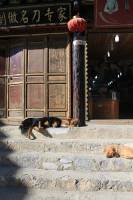Legend of Shangri-La
Shangri-La is a fictional place described in the 1933 novel Lost Horizon by British author James Hilton. Hilton describes Shangri-La as a mystical, harmonious valley, gently guided from a lamasery, enclosed in the western end of the Kunlun Mountains. Shangri-La has become synonymous with any earthly paradise but particularly a mythical Himalayan utopia — a permanently happy land, isolated from the outside world. In the novel Lost Horizon, the people who live at Shangri-La are almost immortal, living years beyond the normal lifespan and only very slowly aging in appearance. The word also evokes the imagery of exoticism of the Orient. In the ancient Tibetan scriptures, existence of seven such places is mentioned as Nghe-Beyul Khimpalung. Khembalung is one of several beyuls ("hidden lands" similar to Shangri-La) believed to have been created by Padmasambhava in the 8th century as idyllic, sacred places of refuge for Buddhists during times of strife (Reinhard 1978).
The use of the term Shangri-La is frequently cited as a modern reference to Shambhala, a mythical kingdom in Tibetan Buddhist tradition, which was sought by Eastern and Western explorers.
Shangri-la, a popular word after World War II and one frequently adopted by stores, hotels and restaurants, signifies a "heaven away from the turmoil of the mundane word". Actually, "Shangri-la" is a Tibetan word, which means "land of sacredness and peace."
The word "Shangri-la" first appeared in its westernized form in James Hiltom's novel The Lost Horizon. This book tells the story of three American pilots who, when flying over the Sino-Indian air route during World War II, crash-land in the midst a beautiful landscape. This place of tranquility and peace is described as having "snow mountains, grasslands, Tibetan people, red soil plateaus, with three rivers flowing traversing the landscape". After being rescued by the local Tibetan people, the three American pilots finally return home.
According to the historical record, in 1944 there was indeed an American transport plane which crashed in the town of Zhongdian within Yunnan province while flying over the Sino-Indian air route. After a careful investigation into these events, it was determined that the beauitful "Shangri-la" described in "The Lost Horizon" is, in fact, the city of Zhongdian, located in the Deqen Tibentan Autonomous Prefecture of Yunnan Province.
Even Today, Zhongdian County remains an untainted natural paradise which retains a mysterious and bewitching quality.Visitors to the Deqen Tibetan Autonomous Prefecture are sure to find themselves in a land where mysterious tranquillity pervades every inch of the ever-changing scenery.
Three snow-capped mountains, Meili, Baimang and Haba, tower magnificently over the landscape. The region is crisscrossed by the Golden Sand, Mekong, and Yangtze Rivers. These snowy peaks form a beautiful backdrop whose beauty is a feast to behold. Mirror-like lakes, scattered across the vast expanse of grassland, look like rich jewels inlaid on a beautiful tapestry.Cattle graze leisurely in the meadows, where exotic flowers and luxuriant grass wave at the request of the gentle breeze.In the depths of the surrounding forests is an exotic world of rare birds and animals.
Mother Nature has endowed Shangri-la with bountiful natural wealth, making the land a happy home for the 100,000 Tibetans, Lisus, Naxis and Yis who call the area their home. As is this pristine natural enviroment, these nationalities are all kind, honest, extremely hospitable to outsiders.The lamasery of "Shangri-la" is Guihua Temple, or Songzanlinbu Lamasery in Tibet. The lamasery, with 800 lamas, resembles Butala Palace of Lasha in its layout. The five-story Tibetan style building is covered with wooden carvings and gold-plated copper tiles. You may have a look at the Gallery of Tibetan Religion and Culture in Deqen.



